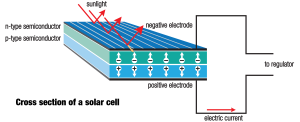The Basics of Solar Cells: How Do They Work
Solar energy is becoming an increasingly popular source of power across the globe, and India is no exception. With its vast potential for harnessing solar power, understanding the basics of solar cells is essential for anyone interested in renewable energy. This blog delves into the fundamental principles of solar cells, how they function, and their significance in the Indian context.
What Are Solar Cells?
Solar cells, also known as photovoltaic (PV) cells, are the building blocks of solar panels. They convert sunlight directly into electricity through the photovoltaic effect. These cells are typically made from semiconductor materials, such as silicon, which have properties that allow them to absorb and convert light energy.
The Photovoltaic Effect
The photovoltaic effect is the process by which solar cells generate electricity. It involves the following steps:
- Absorption of Light: When sunlight strikes the surface of a solar cell, the energy from the light is absorbed by the semiconductor material.
- Electron-Hole Pairs Generation: The absorbed energy excites electrons, causing them to break free from their atoms and create electron-hole pairs.
- Separation of Charges: An electric field within the solar cell separates the free electrons and holes, directing them towards different electrodes.
- Electric Current: When electrons flow through an external circuit to recombine with holes on the other side of the cell, they create an electric current.
Types of Solar Cells
There are several types of solar cells, each with its own advantages and applications:
- Monocrystalline Silicon Cells: These are made from a single continuous crystal structure and are known for their high efficiency and longevity. They are typically more expensive, but they offer better performance.
- Polycrystalline Silicon Cells: Made from multiple silicon crystals, these cells are less efficient but more cost-effective than monocrystalline cells.
- Thin-Film Solar Cells: These are made by depositing one or more layers of photovoltaic material onto a substrate. They are flexible, lightweight, and can be used in a variety of applications, although they generally have lower efficiency.
- Perovskite Solar Cells: A newer technology, these cells promise high efficiency at a lower cost, but they are still being developed for long-term stability.
How Solar Panels Are Made
The manufacturing process of solar panels involves several key steps:
- Purification of Silicon: Raw silicon is refined to remove impurities.
- Ingot Formation: The purified silicon is melted and formed into ingots.
- Wafer Production: The ingots are sliced into thin wafers.
- Cell Fabrication: The wafers are treated to create the photovoltaic effect.
- Panel Assembly: The cells are assembled into panels, including wiring, encapsulation, and mounting on a frame.
Efficiency and Performance
The efficiency of a solar cell is a measure of how much sunlight it can convert into usable electricity. Factors influencing efficiency include material type, cell quality, and environmental conditions. Advances in technology continue to improve the efficiency and reduce the cost of solar cells, making solar energy more accessible.
Applications of Solar Energy in India
India, with its abundant sunlight, is an ideal location for solar energy. The government has set ambitious targets for solar power capacity, aiming to reduce dependence on fossil fuels and promote sustainable development. In India, solar energy applications include:
- Residential Solar Systems: Homeowners can install solar panels on their rooftops to generate electricity and reduce their utility bills.
- Solar Farms: Large-scale solar power plants contribute to the national grid, providing clean energy to thousands of homes and businesses.
- Off-Grid Solutions: In remote and rural areas, solar power can provide reliable electricity where the conventional grid is unavailable.
- Industrial Applications: Factories and commercial buildings use solar energy to power operations and reduce their carbon footprint.
Advantages of Solar Energy
Solar energy offers numerous benefits, particularly for a country like India:
- Renewable Resource: Solar power is an inexhaustible resource, unlike fossil fuels, which are finite.
- Environmental Impact: Solar energy produces no greenhouse gases during operation, reducing pollution and combating climate change.
- Energy Independence: By harnessing solar power, India can reduce its reliance on imported fuels, enhancing energy security.
- Economic Growth: From manufacturing to installation and maintenance, the solar industry creates jobs and stimulates economic development.
Challenges and Solutions
Despite its advantages, solar energy faces several challenges:
- Intermittency: Solar power is dependent on sunlight, which is not constant. Energy storage solutions, such as batteries, are essential to ensure a steady supply of electricity.
- Initial Costs: The upfront cost of installing solar panels can be high, but government incentives and falling prices are making it more affordable.
- Land Use: Large solar farms require significant land, which can compete with agricultural and other land uses. Innovative solutions like floating solar panels on reservoirs are being explored.
The future of solar energy in India looks promising. With continuous technological advancements, supportive government policies, and increasing public awareness, solar energy is set to play a pivotal role in the country’s energy landscape. Innovations in solar cell materials, energy storage, and grid integration will further enhance the viability and efficiency of solar power.
Indo Solar: Pioneering Solar Innovation in India
Indo Solar, a subsidiary of Waaree, is at the forefront of India’s solar revolution. With a commitment to sustainability and innovation, Indo Solar is dedicated to delivering high-quality solar products and solutions that meet the diverse needs of the Indian market.
At Indo Solar, we leverage cutting-edge technology to manufacture top-tier solar cells and panels that are both efficient and durable. Our state-of-the-art facilities ensure that each product adheres to the highest standards of quality and performance. Whether for residential, commercial, or industrial applications, Indo Solar provides solar solutions that empower consumers to harness the power of the sun.
Our mission is to make solar energy accessible to all, driving India’s transition to a cleaner and more sustainable energy future. Through extensive research and development, we continuously improve our products to offer better efficiency and affordability. Indo Solar’s comprehensive range of services includes installation, maintenance, and support, ensuring that our customers have a seamless experience from start to finish.
Indo Solar is not just a company; it’s a movement towards a greener tomorrow. Join us in our journey to illuminate every corner of India with clean, renewable energy. With Indo Solar, the future is bright, and the possibilities are endless. Choose Indo Solar for reliable, sustainable, and innovative solar solutions that cater to the unique energy needs of India. Together, we can power a better future.




